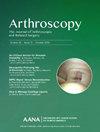Age and Surgical Volume Impact Likelihood and Technique of Lateral Extra-Articular Augmentation During Primary Anterior Cruciate Ligament Reconstruction
IF 5.4
1区 医学
Q1 ORTHOPEDICS
Arthroscopy-The Journal of Arthroscopic and Related Surgery
Pub Date : 2025-08-01
DOI:10.1016/j.arthro.2024.11.068
引用次数: 0
Abstract
Purpose
To evaluate the current utilization trends of practicing surgeons performing and lateral extra-articular augmentation (LEA) at the time of primary anterior cruciate ligament reconstruction (ACLR).
Methods
The survey was distributed via e-mail in August 2023 to members of the Arthroscopy Association of North America who identified as knee surgeons and was available online on the Arthroscopy Association of North America website from January to September 2023. The 18-question survey was designed regarding surgeons’ surgical utilization patterns of LEA during ACLR. Survey questions were created based on prior published research and recommendations regarding indications for LEA, as well as surgeon factors that have been shown to influence operative decision-making. Data were analyzed by surgeon geographics, procedure preferences, patient-based decision factors, surgeon-based decision factors, and surgeon age.
Results
The survey was completed by 165 sports medicine surgeons who identified as arthroscopic knee surgeons. Majority practice types included private practice (42.1%), academic centers (26.8%), and hospital systems (20.7%). Surgeon age was 50.36 years (range, 33-77 years). In total, 6.8% perform <20 ACLRs per year, 30.2% perform 20 to 40, 26.5% perform 40 to 60, 10.5% perform 60 to 80, and 25.9% perform >80 per year. Of the surgeons, 79.4% conduct LEA, with the modified Lemaire being the most common technique (43.5%), followed by other lateral extra-articular tenodesis (LET) techniques (42.0%) and anterolateral ligament reconstruction (ALL) (27.5%). Some surgeons (14.5%) use more than 1 technique. High-volume (>60 ACLR/year) surgeons were more likely to perform LEA (23.1% vs 10.0%, P = .061) and more likely to perform anterolateral ligament reconstruction (32.2% vs 16.5%, P = .034). Younger surgeons (age <50) were more likely to use the modified Lemaire (44.4% vs 24.3%, P = .014). Decision-making to perform LEA weighted highly on patient hyperlaxity, pivot-shift severity, knee hyperextension, sport type, and age, respectively. The most reported surgeon-related factor influencing LEA utilization was training bias (38.9%).
Conclusions
Most orthopaedic surgeons with diverse geographics, demographics, practice setting, and ACLR volume perform LEA. Younger surgeons perform more frequently LEA, and surgeons admit to training bias in decision-making. Patient factors highly impacting utilization of LEA are hyperlaxity, pivot-shift severity, knee hyperextension, sport, and age.
Clinical Relevance
LEA procedures for ACLR have become increasingly utilized in populations at high risk for rerupture. However, there is not currently a clear standard of care with regard to LEA procedure type or indications for augmentation.
年龄和手术量影响原发性前十字韧带重建中外侧关节外扩创的可能性和技术。
目的:本研究旨在评估执业外科医生在初次前交叉韧带重建术(ACLR)时进行关节外侧增量术(LEA)的当前使用趋势:该调查于 2023 年 8 月通过电子邮件发送给北美关节镜协会 (AANA) 的膝关节外科医生会员,并于 2023 年 1 月至 9 月在 AANA 网站上在线发布。该调查共设计了 18 个问题,内容涉及外科医生在 ACLR 期间对 LEA 的手术使用模式。调查问题是根据之前发表的有关 LEA 适应症的研究和建议以及外科医生影响手术决策的因素而设计的。我们按照外科医生的地理位置、手术偏好、患者决策因素、外科医生决策因素和外科医生年龄对数据进行了分析:共有 165 名运动医学外科医生完成了调查,他们都是膝关节镜外科医生。主要执业类型包括私人诊所(42.1%)、学术中心(26.8%)和医院系统(20.7%)。外科医生的年龄为 50.36 岁(33-77 岁不等)。6.8%的外科医生每年进行小于 20 例 ACLR,30.2% 的外科医生每年进行 20-40 例 ACLR,26.5% 的外科医生每年进行 40-60 例 ACLR,10.5% 的外科医生每年进行 60-80 例 ACLR,25.9% 的外科医生每年进行大于 80 例 ACLR。79.4%的外科医生进行 LEA。改良 Lemaire 是最常见的技术(43.5%),其次是其他外侧关节外腱鞘挛缩(LET)技术(42.0%)和前外侧韧带重建(ALL)技术(27.5%),有些外科医生(14.5%)使用一种以上的技术。高手术量(大于 60 例 ACLR/年)的外科医生更有可能使用 LEA(23.1% vs 10.0%,P=0.061),也更有可能使用 ALL(32.2% vs 16.5%,P=0.034)。更年轻的外科医生(年龄 结论:大多数骨科医生都是年轻的外科医生:绝大多数骨科医生在不同的地理位置、人口统计、执业环境和前交叉韧带置换术量下都会进行 LEA。年轻外科医生进行 LEA 的频率更高,外科医生承认在决策时存在培训偏差。对使用LEA影响较大的患者因素包括过度松弛、枢轴移位严重程度、膝关节过伸、运动和年龄:前交叉韧带重建的LEA手术越来越多地用于再次断裂的高危人群。然而,目前在LEA手术类型或增强适应症方面还没有明确的护理标准。
本文章由计算机程序翻译,如有差异,请以英文原文为准。
求助全文
约1分钟内获得全文
求助全文
来源期刊
CiteScore
9.30
自引率
17.00%
发文量
555
审稿时长
58 days
期刊介绍:
Nowhere is minimally invasive surgery explained better than in Arthroscopy, the leading peer-reviewed journal in the field. Every issue enables you to put into perspective the usefulness of the various emerging arthroscopic techniques. The advantages and disadvantages of these methods -- along with their applications in various situations -- are discussed in relation to their efficiency, efficacy and cost benefit. As a special incentive, paid subscribers also receive access to the journal expanded website.

 求助内容:
求助内容: 应助结果提醒方式:
应助结果提醒方式:


